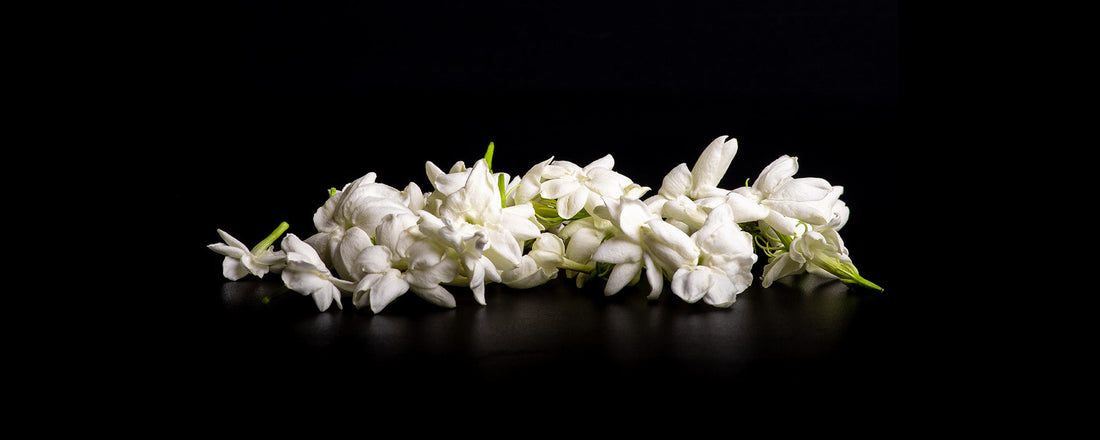Jasmine is one of the most cherished flowers in the world of fragrance. Its captivating scent has graced perfumes for centuries, weaving its way from ancient rituals to modern perfumery. But what does jasmine smell like? This guide delves into the nuances of jasmine’s scent profile, exploring its floral heart, musky depth, and aromatic versatility.
What Is Jasmine?
Jasmine is a small, star-shaped flowering plant known for its strong, sweet scent. It belongs to the olive family (Oleaceae), which also includes olive and ash trees.
There are over 200 species, and they grow best in warm, sunny climates. The name "jasmine" comes from the Persian word "yasmin," meaning "gift from God."
In India, jasmine is used in garlands and ceremonies. The ancient Egyptians used their oil in beauty products. By the 1500s, jasmine became a key ingredient in perfumes from Grasse, France. Today, it’s one of the most valuable ingredients in fine fragrance.
What Does Jasmine Smell Like?
Jasmine smells floral, sweet, fresh, and a little musky. Its top notes can be green, fruity, or slightly spicy. The middle is strong and warm, and this is where the rich floral scent shines. The base is musky and powdery, giving it a sensual and deep finish.
Its scent changes based on the type of jasmine, where it’s grown, and how it’s extracted. Indian jasmine often smells greener and more herbal, while Egyptian jasmine can be sweeter and more like honey.
Jasmine’s olfactory signature is multi-faceted and richly evocative. Here's a breakdown of its scent aspects:
1. Floral
At its core, jasmine is intensely floral. Compared to other floral notes like rose, jasmine is more opulent and exotic, while sharing the creamy richness of ylang-ylang and tuberose.
2. Fresh
Depending on the variety and extraction method, it may exude green notes reminiscent of crushed leaves, dew-kissed petals, or spring air. These fresh elements balance jasmine’s sweetness, adding brightness and lift.
3. Light
Modern perfumery often emphasizes jasmine’s lighter qualities—ethereal, airy, and romantic. When used sparingly or in combination with citrus and aquatic notes, jasmine can evoke a soft, luminous aura, perfect for daytime or minimalist fragrances.
4. Musky
Adding sensual complexity, jasmine contains animalic nuances that can smell musky or slightly leathery. These undertones deepen the fragrance, making it warmer and more intimate. The musky edge contributes to jasmine’s reputation as an aphrodisiac note.
⇒ Maybe you’ll be interested in: What is Musk in Perfume
Where Does the Jasmine Scent Come From?
Producers now use solvent extraction to make jasmine oil.
In the past, they used enfleurage, an old method where they pressed flowers into animal fat to absorb the scent. It is no longer in use.
Today, solvent extraction offers a gentler way to handle delicate flowers and captures their full aroma without using animal-based ingredients.
Producing jasmine absolute is highly labor-intensive.
It takes around 8,000 handpicked jasmine blossoms to make just one milliliter of oil.
Flowers must be harvested by hand before sunrise when they are most fragrant and rich in essential oils.
Jasmine in Perfumery
Jasmine is one of the most iconic florals in fragrance. Known for its soft, yet sensual character, it’s most often used as a middle note, the heart of a perfume that reveals itself once the top notes settle. Its balance of brightness and warmth allows it to soften sharp accords, add depth to florals, or bring radiance to woods and musks.
Widely used across both classic and niche perfumes, jasmine plays a starring role in everything from timeless floral bouquets to modern, layered blends. Its versatility makes it a favorite among perfumers for building richness and emotional tone into a fragrance.
Though its presence is sometimes quiet or blended deep into the composition, jasmine’s influence is unmistakable, elegant, luminous, and deeply expressive.
Variations of Jasmine in Perfumery
Explore how jasmine varieties inspire elements in our eau de parfum range. Here are the main types of jasmine used in perfumery:
- Jasmine Sambac: Also known as Jasminum sambac or Arabian jasmine. It has a strong, sweet, and slightly fruity scent. Often used in rich and bold perfumes, it adds depth and intensity.
- Jasmine Grandiflorum: Also called Jasminum grandiflorum or Spanish jasmine. Its scent is softer and more floral, with a sweet and rich aroma. Historically used for medicinal purposes as well.
- Jasmine Auriculatum: Found in India and the Andaman Islands. It has a sweet, floral, and lightly spicy scent. This type is also used in decorations and festivals in Indian culture.
- Jasmine Absolute: A concentrated oil made from jasmine flowers using solvent extraction. It has an intense and long-lasting floral aroma and is widely used in high-end perfumes and aromatherapy.
- Synthetic Jasmine: Made from lab-created compounds that mimic natural jasmine. It’s less complex but more affordable and consistent. Often used in commercial fragrances.
Each type adds a different nuance, from creamy and exotic to fresh or spicy, helping perfumers create a variety of scents.
Benefits of Jasmine in Aromatherapy
Jasmine isn’t just used for its scent; it offers real wellness benefits too. Research shows that jasmine can fight bacteria like E. coli and candida, thanks to its natural antibacterial properties. It also affects GABA, a brain chemical that helps calm the nervous system.
Here’s how jasmine can support your well-being:
- Reduces stress and anxiety: The scent has a calming effect on both mind and body.
- Improves mood and energy: It lifts your spirits and helps fight fatigue.
- Enhances intimacy: Known as the “perfume of love,” jasmine can increase feelings of sensuality.
- Supports restful sleep: Its soothing aroma promotes relaxation at bedtime.
These qualities make jasmine a top choice for aromatherapy, whether in essential oils, diffusers, or candles.
What Scents Pair Well With Jasmine?
Jasmine is a remarkably adaptable floral note that pairs beautifully with a variety of scent families. Its character can shift depending on the ingredients it’s blended with, creating fragrances that range from bright and airy to rich and sensual.
- Citrus notes like bergamot, mandarin, and neroli highlight jasmine’s freshness. These pairings often result in light, uplifting compositions perfect for daytime or warmer weather.
- For a deeper, more grounded profile, woods and resins such as sandalwood, cedar, and amber add warmth and softness. Together, they create a smooth, enveloping base that brings out jasmine’s more sensual qualities.
- Spices like cardamom are found in Le Bain de Lulu, and pink pepper in Faisan d'Or.** They give the blend a subtle edge while allowing the floral heart to stay in focus.
- Other white florals, such as orange blossom in Mischa and tuberose, build on jasmine’s creamy floral body. These combinations often feel lush, romantic, and full.
- In more modern blends, jasmine also works well with clean musks and soft fruit notes, creating a fresh yet layered effect that’s both elegant and approachable.
Its ability to harmonize with so many notes is part of what makes jasmine a lasting favorite in perfumery. Whether the goal is brightness, warmth, softness, or contrast, jasmine blends beautifully into the story.
Conclusion: The Essence of Jasmine: A Lasting Impression
Jasmine is a fragrance note like no other, complex, captivating, and endlessly versatile. Whether as a radiant heart note or a sensual whisper, jasmine enriches every composition it touches. If you're still asking, what does Jasmine smell like, just remember: it's a timeless blend of floral richness, sweet freshness, and sensual depth.
For those looking to experience fragrance in its most delicate and artfully blended form, explore our indie perfume collection that values nuance, balance, and quiet sophistication in every bottle.
FAQ
1. Is jasmine sweet or musky?
It is both. Jasmine has a sweet, floral core with musky, animalic undertones that add depth and warmth.
2. What’s the difference between natural and synthetic jasmine?
Natural jasmine absolute offers a complex and authentic aroma, but is pricier than other versions. Synthetic versions provide cost-effective, consistent alternatives with a lighter scent profile.
3. Does Arabian jasmine smell good?
Arabian jasmine (Jasminum sambac) has an intense, fruity, and slightly musky aroma. It’s highly valued in perfumery for its depth and warmth.
4. Does gardenia smell like jasmine?
Gardenia and jasmine both belong to the floral family and share creamy, sweet characteristics, but gardenia is generally heavier and creamier, while jasmine has a fresher, greener note.
5. Does jasmine smell like honeysuckle?
Jasmine and honeysuckle can both be sweet and floral, but honeysuckle is lighter and more sugary, while jasmine is deeper and more complex.
6. Does moringa smell like jasmine?
No, moringa has a more earthy, green scent. It does not resemble the floral sweetness of jasmine.
7. Does tuberose smell like jasmine?
Tuberose and jasmine both have sweet, floral scents, but they’re not quite the same.
Tuberose smells creamier and deeper like a thick, velvety blanket.
On the other hand, Jasmine is a little fresher and brighter, more like a soft breeze through a blooming garden.


